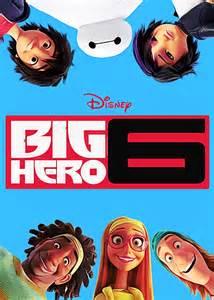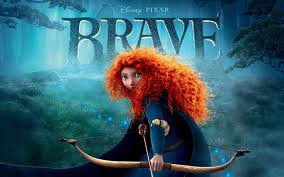Disney has been dishing out tales about young heroes for generations, from the likely to the unlikely, from the princely to the fuzzy, so it’s no surprise that their latest animated film, Big Hero 6, returns in full swing to such heroics with a young hero’s journey to maturation. Living in a futuristic world in a fused Japanese-American society, Hiro Hamada stands out as a young man of exponential potential, a bona fide genius. Even his name suggests his chance for greatest, a Japanese name used as a pun in the film for the English word “hero.” After graduating high school at the age of thirteen, however, our soon-to-be hero, Hiro, seems more like a teenager with too much time on his hands, spending his days inventing robots to beat the pants off his opponents in robot wars, and raking in cash by winning bets placed on these robot games. Fortunately, his older brother, Tadashi, is there to guide him down the right path. But when Tadashi is killed as a result of someone’s devious plans to steal an invention of Hiro’s, Hiro decides to catch the person responsible. Joined by his friends and Baymax, the robot his brother had created, they turn themselves into a team of superheroes up to the job of bringing down a super villain. Yet for all its classic stamps of a hero’s tale, this film makes some notable changes that push it beyond being just another action flick.
Perhaps most apparent of these changes is the diversity of the characters. Gone are visions of an all-white cast in Big Hero 6, replaced with a racially diverse group of heroes fit for a modern audience. Hiro and his friends come from a number of racial backgrounds, but none of them are limited to “representing” their race, instead acting as unique individuals. Not only is this group racially diverse, but also offers characters of both sexes who, for the most part, pull away from stereotypical presentations of gender. For example, independent Go Go may be a petite woman, but she’s not afraid of breaking rules or charging the enemy while Wasabi is a strong male character who prefers caution, order, and rules. I was most fearful of Honey Lemon who, at first glance, appears to be a stereotypical girly-girl–blonde, chipper, and fashionable. But the movie does a good job of showing that Honey Lemon is indeed all of those things, but she’s also a brilliant chemist, and certainly not confined to being one thing or the other. Even Fred, a “dude” who harkens back to stereotypes of young men as unhygienic and not particularly bright has some surprises up his sleeve. It’s also clear that Fred isn’t supposed to representative of male behavior.
Speaking of how men are represented in Big Hero 6, one of my favorite aspects of this film is how Hiro’s narrative diverges from typical representations of masculinity. Now, in many regards, Hiro acts as a traditional hero, but Big Hero 6 does something that I don’t see very often; it scrapes away what appears to be just another tale of a righteous hero taking down a bad guy to examine issues of revenge and grief.
The revenge plot is nothing new. I’ve seen the loss of a loved one (usually a woman) used as a plot device to spur a male character into action. Yet in many of the examples I have seen or read, the focus becomes his actions instead of his emotions. In these cases, bursts of anger, while an expression of grief, obscure the male character’s sadness over the loss, and put the consumer’s attention on his actions toward the perpetrator as that anger takes the form of violence. Of course, anger is a natural reaction, too, but when fiction puts the emphasis on the male character’s anger without fully exploring it as a facet of his sorrow, it reinforces concepts of masculinity that suggest that the acceptable way for men to express sadness is through anger. Because revenge plots often are part of action films, the stereotype gets taken one step further, with the character acting on on his anger through violence. As such, these representations take us even further from reflections of the male character’s psychological state.
Big Hero 6, however, turns our attention back to emotions. Much of this is thanks to Baymax, a puff white robot that looks like a walking marshmallow. Tadashi created Baymax act as a kind of robotic nurse so Baymax’s priority remains both Hiro’s physical and mental health even as Hiro tries to make him into a fighting machine, reminding viewers of the difficult psychological issues that Hiro is experiencing. Hiro’s attitude toward Baymax reveals his attitude toward his mental health; he would rather fight than address his grief, and he spends much of the movie trying to resist facing his emotions. But his emotions are at the heart of everything. The movie carefully depicts his depression, managing to show a grief-stricken Hiro shutting himself off without making it too depressing for kids, and how he latches onto catching the person responsible for Tadashi’s death in order to pull himself out of his depression.
While it may seem like Hiro’s emotional status takes a backseat to action as Hiro, Baymax, and company prep themselves for a fight, closer inspection reveals the movie setting up a contrast of two different ways of handling Tadashi’s death: on the one hand is revenge, and on the other is interaction with friends and family. Hiro assures Baymax–and perhaps himself, as well–that catching the guy will solve his mental health problems, but what Big Hero 6 argues can truly ease Hiro’s pain is the company of his friends and Baymax. With their help, Hiro slowly comes to terms with his brother’s death, his own grief, and, in turn, is able to keep his brother’s will alive. The path of revenge and violence, in contrast, leads only to further destruction in this narrative.
Despite its status as a kid’s movie, Big Hero 6 delves into some hefty discussions of love, grief, and violence. Big Hero 6 suggests that violence won’t solve the true aliment, and, with the healing touch of Baymax, asks its male lead to confront his loss in another way, a refreshing change to presentations of heroes handling sadness. Of course, Disney provides for those itching for a good old fashioned hero-villian face-off, complete with plenty of flying robots, superhero suits, and even a classic revenge plot in Big Hero 6, but in the end, the movie’s real magic shines where the standard hero’s narrative has been reworked to suit a more modern audience.
























